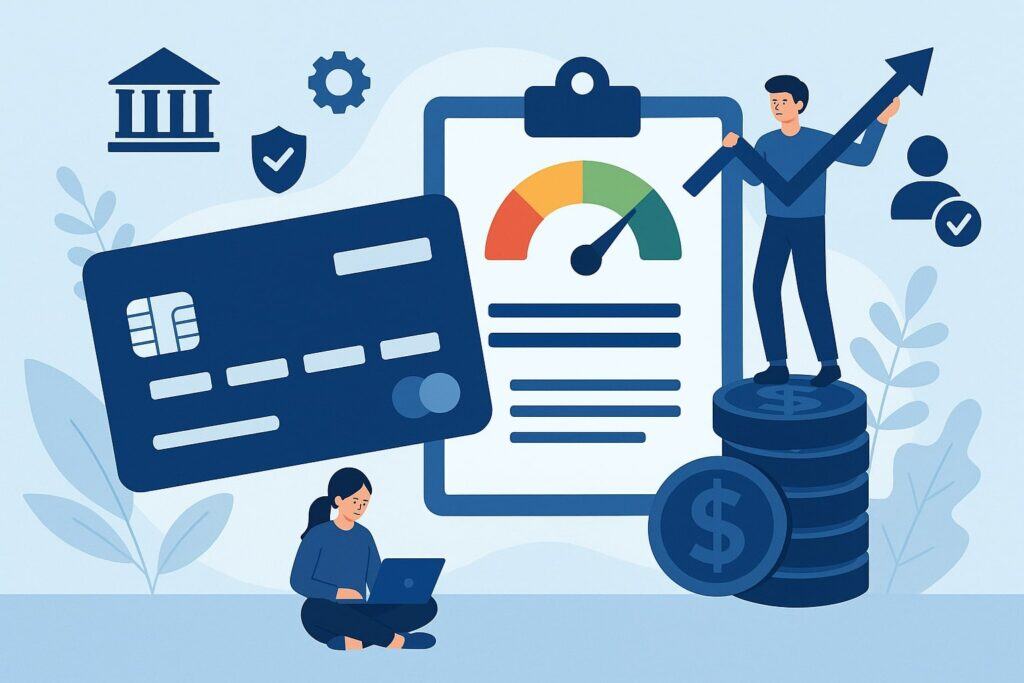
How to Improve Your Chances of Loan Approval
Applying for a loan is one of the most significant financial decisions you can make, whether it’s for buying a home, funding a business, consolidating debt, or covering unexpected expenses. Yet, many people struggle with loan rejections or face difficulties securing favorable terms because they aren’t fully prepared before submitting their application.
Improving your chances of loan approval requires more than just filling out a form; it involves strategic planning, financial discipline, and a deep understanding of how lenders assess risk.
This guide provides a comprehensive roadmap to increase your odds of getting approved. We will dive into creditworthiness, income stability, debt management, documentation, lender research, and more.
Each section will break down key factors that lenders analyze and offer practical steps you can take to position yourself as a low-risk borrower. By applying these principles consistently, you can not only secure a loan but also negotiate better interest rates and repayment terms.
Understanding Loan Approval Criteria

Before attempting to improve your chances, it’s critical to understand what lenders look for when reviewing applications. At its core, loan approval is about risk assessment—lenders want to ensure that you can repay the borrowed money without defaulting.
They use several criteria to gauge this, and every borrower is evaluated based on a combination of these factors.
Credit Score and History
One of the most influential elements is your credit score. Ranging typically from 300 to 850, this number reflects your borrowing history, repayment patterns, and financial responsibility. Lenders often consider anything above 670 as “good,” while scores above 740 are generally classified as “excellent.”
However, creditworthiness isn’t solely about the number—it also includes your credit history, which details how you’ve handled debts in the past. A history of on-time payments builds trust, while late payments, defaults, or bankruptcies raise red flags.
Debt-to-Income Ratio (DTI)
Another major factor is your debt-to-income ratio, which compares your monthly debt obligations to your monthly income. For example, if you earn $5,000 a month and your debts total $2,000, your DTI is 40%.
Most lenders prefer DTIs under 36%, though some may accept higher depending on the loan type. A lower DTI signals that you’re not financially overextended, making you more capable of managing additional debt.
Income Stability
Stable income reassures lenders that you have a reliable way to make monthly payments. This doesn’t just mean a high salary—it also includes steady employment history, consistent paychecks, and predictable earnings.
Someone with a moderate income but ten years at the same job may be considered less risky than someone with fluctuating freelance income, even if the latter earns more in a good month.
Collateral and Down Payment
For secured loans like mortgages or auto loans, collateral plays a significant role. Lenders want to ensure they can recover losses if you fail to repay. A larger down payment also reduces lender risk by lowering the total loan amount and showing your commitment to the investment.
Credit Mix and Length of History
Lenders also value diversity in your credit accounts—credit cards, student loans, auto loans, mortgages. Having a mix demonstrates that you can responsibly handle different types of credit. Similarly, the length of your credit history matters.
A long history provides lenders with more data to analyze, while a thin or new file makes them less confident. By understanding these criteria, you can strategically work on the areas where you may fall short.
In the following sections, we’ll explore actionable ways to strengthen each factor and significantly improve your chances of loan approval.
Building and Maintaining a Strong Credit Profile

Your credit profile is like a financial résumé—it tells lenders how reliable you are in managing borrowed money. Improving this profile is one of the most powerful steps you can take to increase your loan approval odds. But building a good credit score and maintaining it requires time, consistency, and smart financial habits.
Paying Bills on Time
The single biggest factor in credit scoring models is your payment history, accounting for 35% of your FICO score. Late payments, especially those over 30 days, can severely damage your score and remain on your report for years. Setting up automatic payments or reminders can help ensure you never miss a due date.
Reducing Credit Utilization
Credit utilization—how much of your available credit you’re using—should ideally stay under 30%. For example, if your total credit limit is $10,000, try to keep balances below $3,000. Lenders see high utilization as a sign that you might be financially overextended. Paying down credit cards or requesting higher credit limits can improve this ratio.
Avoiding Frequent Hard Inquiries
Every time you apply for new credit, a hard inquiry appears on your report, which can temporarily lower your score. Too many inquiries in a short time suggest financial distress. It’s better to limit new applications and space them out. Prequalification tools, which use soft inquiries, allow you to shop for loans without hurting your score.
Keeping Old Accounts Open
Length of credit history contributes about 15% to your score. Even if you don’t use an old credit card, keeping it open can help by increasing your average account age and overall credit limit. Closing accounts can shorten your history and increase utilization.
Correcting Errors on Your Report
Mistakes happen. Sometimes credit reports include errors like accounts that don’t belong to you or incorrect late payments. Reviewing your credit reports from the three major bureaus—Experian, Equifax, and TransUnion—at least annually ensures accuracy. If you find errors, dispute them immediately to have them corrected.
By maintaining these habits, your credit profile becomes more appealing to lenders. A higher score not only increases approval chances but also opens the door to better interest rates and terms, saving you money in the long run.
Demonstrating Income Stability and Employment History

Beyond credit, lenders want reassurance that you have consistent income to support loan repayment. This section focuses on how to present your financial situation in the best possible light.
Steady Employment
If you’ve been with the same employer for several years, it signals reliability. Frequent job changes, on the other hand, may raise doubts about income stability. If you are planning a major loan application, it’s wise to avoid switching jobs within six months of applying, unless it significantly boosts your salary or position.
Documenting Income
Whether you’re a salaried employee, self-employed, or a freelancer, you’ll need to provide documentation. Pay stubs, tax returns, and bank statements are common requirements. Self-employed individuals may need profit-and-loss statements or 1099 forms. Keeping organized financial records makes the application smoother and demonstrates professionalism.
Additional Income Sources
If you have secondary income—such as rental income, dividends, or side hustles—document them thoroughly. Lenders are more likely to count these sources if they are consistent and verifiable. For example, sporadic gig income may not weigh heavily, but long-term rental property income is considered reliable.
Reducing Job Gaps
Extended gaps in employment history can concern lenders, as they may indicate instability. If you have such gaps, be prepared to explain them. A letter of explanation that highlights how you’ve regained financial stability can mitigate concerns.
By emphasizing income stability and employment history, you demonstrate your ability to maintain regular payments. Lenders see you as a lower-risk borrower, which improves your approval odds significantly.
Managing Debt and Improving Debt-to-Income Ratio
Even with excellent credit, high debt levels can hurt your loan approval chances. Lenders want assurance that new debt won’t overwhelm your finances. Managing debt and improving your debt-to-income ratio (DTI) is essential.
Paying Down Existing Debt
Start by tackling high-interest debts like credit cards. Paying them off reduces your monthly obligations and lowers your DTI. Debt snowball or avalanche methods can be effective strategies, depending on whether you prefer to clear smaller balances first or prioritize high-interest accounts.
Avoiding New Debt
Taking on new debt shortly before applying for a loan increases your DTI and suggests financial instability. Hold off on large purchases, new credit cards, or additional loans until after your application is processed.
Consolidating Debt
Debt consolidation loans or balance transfers can streamline payments and lower interest rates, making it easier to manage. However, be careful not to run up new balances after consolidating, as that can worsen your financial picture.
Increasing Income
While reducing debt is one way to improve DTI, increasing income is another. Negotiating a raise, starting a side business, or monetizing skills can boost your earnings and balance the ratio.
Demonstrating Responsible Debt Use
It’s important to show that you can handle debt responsibly. Lenders don’t just want to see low balances; they want evidence of consistent, on-time payments. Even paying slightly more than the minimum demonstrates commitment to repayment.
By lowering your DTI and showing responsible debt management, you present yourself as financially balanced. This is one of the strongest signals to lenders that you can handle additional debt.
Preparing Documentation and Financial Records
Lenders are not only interested in numbers; they also need proof. Having well-prepared documentation can speed up the process and demonstrate your reliability.
Commonly Required Documents
- Proof of identity: Driver’s license, passport, or Social Security card.
- Proof of income: Pay stubs, W-2s, tax returns, or 1099s.
- Bank statements: To verify assets and cash flow.
- Employment verification: Sometimes lenders contact your employer directly.
- Collateral documents: Titles, deeds, or appraisals if applying for a secured loan.
Organization Matters
Submitting incomplete or disorganized paperwork delays approvals. Having documents ready in a neatly prepared folder, whether physical or digital, shows preparedness and reduces lender frustration.
Showing Financial Responsibility
Beyond required documents, including optional ones like a personal budget, investment records, or proof of insurance can show you are organized and financially aware. This goes a long way in building confidence with the lender.
By ensuring your paperwork is thorough and accurate, you make the approval process easier and create a positive impression.
Researching and Choosing the Right Lender
Not all lenders are created equal. Your approval chances may vary depending on where you apply.
Traditional Banks vs. Credit Unions
Banks often have stricter requirements, while credit unions may be more flexible, especially if you have a relationship with them.
Online Lenders
Digital lenders may offer quicker approvals and competitive rates, especially for personal loans. However, some may also charge higher fees.
Matching Loan Products
Applying for the wrong type of loan reduces your chances. For example, seeking a large unsecured loan with poor credit is unlikely to succeed. Instead, researching lenders that specialize in borrowers with your profile increases success.
Building Relationships
Establishing a relationship with a lender before applying can be advantageous. Maintaining accounts, credit cards, or savings with a bank or credit union may improve approval odds due to familiarity.
Careful lender selection ensures you’re applying where your chances are strongest.
Strengthening Your Application With Collateral and Cosigners
Sometimes, even with preparation, your profile may not fully meet a lender’s requirements. In such cases, collateral or a cosigner can improve your chances.
Collateral
For secured loans, offering valuable collateral reduces the lender’s risk. Examples include vehicles, real estate, or savings accounts. The more secure the loan, the better your approval odds.
Cosigners
A cosigner with good credit and income can significantly boost your approval chances, especially for younger borrowers or those with limited credit history. The cosigner agrees to take responsibility if you default, which reassures the lender.
However, asking someone to cosign is a big responsibility. Ensure you can handle the repayment to protect your relationship and the cosigner’s credit.
Frequently Asked Questions (FAQs)
Q1. What credit score do I need for loan approval?
Answer: The credit score required depends on the type of loan and the lender. For conventional mortgages, a score above 620 is often necessary, while FHA loans may accept scores as low as 580.
Personal loan lenders may set minimums around 600–660. However, the higher your score, the better your terms. Even if your score meets the minimum, aiming for 700+ greatly increases approval odds.
Remember, though, lenders look at more than just the score. Your history of payments, credit utilization, and overall debt load also play critical roles. This means that even with a “good” score, risky habits like high balances or frequent inquiries can hurt approval chances.
Q2. How can I get a loan with bad credit?
Answer: It’s possible to get a loan with bad credit, but options may be limited, and interest rates will likely be higher. Some strategies include applying for secured loans backed by collateral, using credit-builder loans, or asking a trusted cosigner for support.
Subprime lenders and online marketplaces may also approve lower-credit borrowers, though at the cost of higher fees.
The key is to show improvement and responsibility. Even with bad credit, demonstrating consistent income, reduced debt levels, and a willingness to provide collateral can sway some lenders.
Additionally, focusing on improving your credit before applying can open up far more affordable options in the near future.
Q3. Does applying for multiple loans hurt my chances?
Answer: Yes and no. Multiple hard inquiries within a short period can lower your credit score slightly. However, many credit scoring models treat multiple inquiries for the same type of loan (such as mortgage or auto loans) within a 30–45 day window as one inquiry. This is because the system assumes you’re rate shopping, not desperately seeking credit.
That said, applying for too many different types of loans at once (a credit card, a personal loan, and a car loan) raises red flags. Lenders may interpret this as financial stress, which reduces approval odds. The best approach is to research thoroughly first, then apply only to lenders where you are confident of approval.
Q4. Can increasing income improve approval chances?
Answer: Yes, increasing income is one of the most effective ways to strengthen your loan application, especially if your debt-to-income ratio is high. Lenders want assurance that you have sufficient cash flow to cover new loan payments. A higher income provides that cushion.
This doesn’t mean you need to double your salary overnight. Even small, consistent boosts—like taking on freelance projects, monetizing a hobby, or securing a part-time job—can make a difference. The key is documentation; lenders will only consider income that is stable and verifiable.
Q5. Should I apply with multiple lenders at once?
Answer: Applying with multiple lenders can help you compare terms and increase your chances, but it must be done strategically. As mentioned earlier, credit scoring models group similar loan inquiries together if done within a short window. This allows you to “shop around” without significant harm.
The benefit is that you may find a lender willing to offer better rates or more favorable terms. However, submitting too many scattered applications over time hurts your credit. Focus your applications on lenders most likely to approve based on your profile.
Conclusion
Improving your chances of loan approval is not about luck—it’s about preparation, discipline, and smart decision-making. By strengthening your credit profile, demonstrating stable income, lowering your debt-to-income ratio, preparing proper documentation, and choosing the right lender, you significantly increase your odds of success.
Remember, every action you take today—whether it’s paying a bill on time, reducing debt, or organizing your records—contributes to building a stronger financial foundation for tomorrow. With patience and consistent effort, you can not only get approved but also secure favorable loan terms that save you money and reduce stress in the long run.